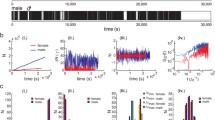Abstract
This paper theoretically and qualitatively describes the calling behavior of the Japanese tree frog Hyla japonica with a simple model of phase oscillators. Experimental analysis showed that while an isolated single male frog called nearly periodically, two interacting male frogs called periodically but alternately, with little overlap. We model these phenomena as a system of coupled phase oscillators, where each isolated oscillator behaves periodically as a model of the calling of a single frog, and two coupled oscillators show antiphase synchronization, reflecting the alternately calling behavior of two interacting frogs. Then, we extend the model to a system of three coupled oscillators virtually corresponding to three interacting male frogs, and analyse the nonlinear dynamics and the bifurcation. We also discuss the biological meaning of the calling behavior and its possible application to artificial life and robotics.
Similar content being viewed by others
References
Winfree AT (1967) Biological rhythms and the behavior of population of coupled oscillators. J Theor Biol 16:15–42
Kuramoto Y (1984) Chemical oscillations, waves, and turbulence. Springer, Berlin
Ermentrout GB, Rinzel J (1984) Beyond a pacemaker’s entrainment limit: phase walk-through. Am J Physiol 246:102–106
Mirollo RE, Strogatz SH (1990) Synchronization of pulse-coupled biological oscillators. Siam J Appl Math 50:1645–1662
Strogatz SH (1994) Nonlinear dynamics and chaos. Perseus, Cambridge
Hoppensteadt FC, Izhikevich EM (1997) Weakly connected neural networks. Springer, New York
Pikovsky A, Rosenblum M, Kurth J (2001) Synchronization: a universal concept in nonlinear sciences. Cambridge University Press, Cambridge
Loftus-Hills JJ (1974) Analysis of an acoustic pacemaker in Strecker’s chorus frog Pseudacris streckeri (Anura:Hyli-dae). J Comp Physiol 90:75–87
Lemon RE, Struger J (1980) Acoustic entrainment to randomly generated calls by the frog, Hyla crucifer. J Acoust Soc Am 67:2090–2095
Aihara I, Kitahata H, Horai S, et al. (2006) Synchronization experimentally observed in calling behaviors of Japanese rain frogs (Hyla japonica). Proceedings of the 2006 International Symposium on Nonlinear Theory and its Applications IEICE, pp 767–770
Aihara I, Horai S, Kitahata H, et al. (2007) Dynamical calling behaviors experimentally observed in Japanese tree frogs (Hyla japonica). IEICE Trans Fundamentals, E90-A:2154–2161
Matsui M (1996) Natural history of the amphibia (in Japanese). University of Tokyo Press, Tokyo
Iwasawa H, Kuramoto M (1996) Systematic zoology, vol. 9. Vertebrata: Pisces/Amphibia/Reptilia (in Japanese). Nakayama-Shoten, Tokyo
Matsubashi T, Okuyama F (2002) Frogs and toads of Japan + salamander (in Japanese). Yama-Kei Publishers, Tokyo
Yoshimoto M, Yoshikawa K, Mori Y (1993) Coupling among three chemical oscillators: synchronization, phase-death and frustration. Phys Rev E 47:864–874
Miyazaki J, Kinoshita S (2006) Method for determining a coupling function in coupled oscillators with application to Belousov-Zhabotinsky oscillators. Phys Rev E 74:056209
Author information
Authors and Affiliations
Corresponding author
About this article
Cite this article
Aihara, I., Kitahata, H., Yoshikawa, K. et al. Mathematical modeling of frogs’ calling behavior and its possible application to artificial life and robotics. Artif Life Robotics 12, 29–32 (2008). https://doi.org/10.1007/s10015-007-0436-x
Received:
Accepted:
Published:
Issue Date:
DOI: https://doi.org/10.1007/s10015-007-0436-x




